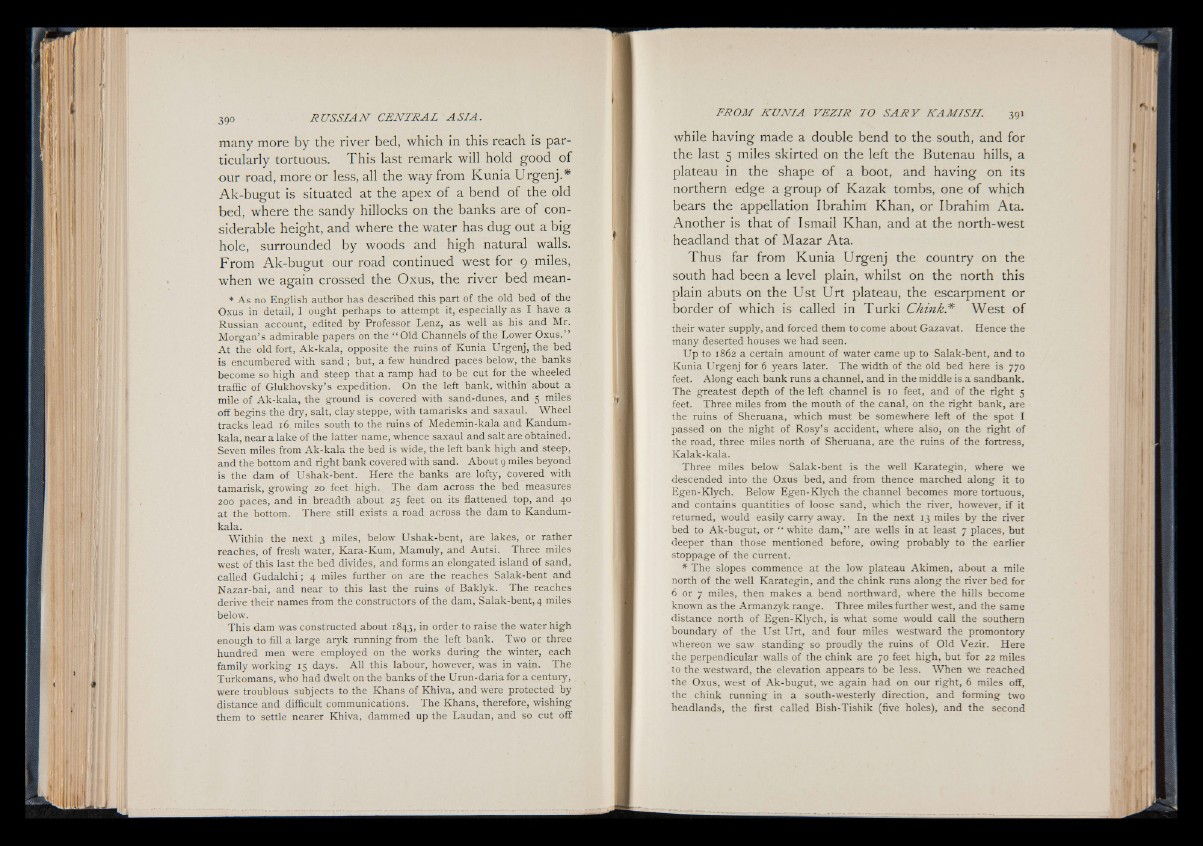
many more by the river bed, which in this reach is particularly
tortuous. This last remark will hold good of
our road, more or less, all the way from Kunia Urgenj.*
Ak-bugut is situated at the apex of a bend of the old
bed, where the sandy hillocks on the banks are of considerable
height, and where the water has dug out a big
hole, surrounded by woods and high natural walls.
From Ak-bugut our road continued west for 9 miles,
when we again crossed the Oxus, the river bed mean-
* As no English author has described this part of the old bed of the
Oxus in detail, I ought perhaps to attempt it, especially as I have a
Russian account, edited by Professor Lenz, as well as his and Mr.
Morgan’s admirable papers on the “ Old Channels of the Lower Oxus.”
At the old fort, Ak-kala, opposite the ruins of Kunia Urgenj, the bed
is encumbered with sand ; but, a few hundred paces below, the banks
become so high and steep that a ramp had to be cut for the wheeled
traffic of Glukhovsky’ s expedition. On the left bank, within about a
mile of Ak-kala, the ground is covered with sand-dunes, and 5 miles
off begins the dry, salt, clay steppe, with tamarisks and saxaul. Wheel
tracks lead 16 miles south to the ruins of Medemin-kala and Kandum-
kala, near a lake of the latter name, whence saxaul and salt are obtained.
Seven miles from Ak-kala the bed is wide, the left bank high and steep,
and the bottom and right bank covered with sand. About 9 miles beyond
is the Ham of Ushak-bent. Here the banks are lofty, covered with
tamarisk, growing 20 feet high. The dam across the bed measures
200 paces, and in breadth about 25 feet on its flattened top, and 40
at the bottom. There still exists a road across the dam to Kandum-
kala.
Within the next 3 miles, below Ushak-bent, are lakes, or rather
reaches, of fresh water, Kara-Kum, Mamuly, and Autsi. Three miles
west of this last the bed divides, and forms an elongated island of sand,
called Gudalchi; 4 miles further on are the reaches Salak-bent and
Nazar-bai, and near to this last the ruins of Baklyk. The reaches
derive their names from the constructors of the dam, Salak-bent, 4 miles
below.
This dam was constructed about 1843, in order to raise the water high
enough to fill a large aryk running from the left bank. Two or three
hundred men were employed on the works during the winter, each
family working 15 days. All this labour, however, was in vain. The
Turkomans, who had dwelt on the banks of the Urun-dariafor a century,
were troublous subj ects to the Khans of Khiva, and were protected by
distance and difficult communications. The Khans, therefore, wishing
them to settle nearer Khiva, dammed up the Laudan, and so cut off
while having made a double bend to the south, and for
the last 5 miles skirted on the left the Butenau hills, a
plateau in the shape of a boot, and having on its
northern edge a group of Kazak tombs, one of which
bears the appellation Ibrahim Khan, or Ibrahim Ata.
Another is that of Ismail Khan, and at the north-west
headland that of Mazar Ata.
Thus far from Kunia Urgenj the country on the
south had been a level plain, whilst on the north this
plain abuts on the Ust Urt plateau, the escarpment or
border of which is called in Turki Chink.* West of
their water supply, and forced them to come about Gazavat. Hence the
many deserted houses we had seen.
Up to 1862 a certain amount of water came up to Salak-bent, and to
Kunia Urgenj for 6 years later. The width of the old bed here is 770
feet. Along each bank runs a channel, and in the middle is a sandbank.
The greatest depth of the left channel is 10 feet, and of the right 5
feet. Three miles from the mouth of the canal, on the right bank, are
the ruins of Sheruana, which must be somewhere left of the spot I
passed on the night of Rosy’s accident, where also, on the right of
the road, three miles north of Sheruana, are the ruins of the fortress,
Kalak-kala.
Three miles below Salak-bent is the well Karategin, where we
descended into the Oxus bed, and from thence marched along it to
Egen-Klych. Below Egen-Klych the channel becomes more tortuous,
and contains quantities of loose sand, which the river, however, if it
returned, would easily carry away. In the next 13 miles by the river
bed to Ak-bugut, or “ white dam,” are wells in at least 7 places, but
deeper than those mentioned before, owing probably to the earlier
stoppage of the current.
* The slopes commence at the low plateau Akimen, about a mile
north of the well Karategin, and the chink runs along the river bed for
6 or 7 miles, then makes a bend northward, where the hills become
known as the Armanzyk range. Three miles further west, and the same
distance north of Egen-Klych, is what some would call the southern
boundary of the Ust Urt, and four miles westward the promontory
whereon we saw standing so proudly the ruins of Old Vezir. Here
the perpendicular walls of the chink are 70 feet high, but Tor 22 miles
to the westward, the elevation appears to be less. When we reached
the Oxus, west of Ak-bugut, we again had on our right, 6 miles off,
the chink running in a south-westerly direction, and forming two
headlands, the first called Bish-Tishik (five holes), and the second